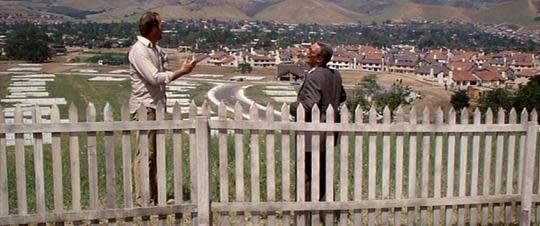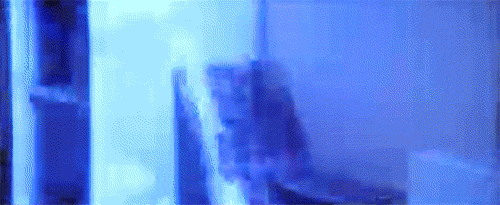Inside the Hell House of the Original 'Poltergeist'

The original ‘Poltergeist’ house (MGM)
Released last Friday, the remake of the 1982 horror classic Poltergeist was greeted with a lukewarm response from critics. In fairness, it was always going to be hard for director Gil Kenan to match the heights reached by the original, which was written and produced by Steven Spielberg and directed by Tobe Hooper.
Both movies depict the terrifying ordeal of a family whose suburban house is haunted by some very angry ghosts. While the new Poltergeist saved money by shooting in Ontario, Canada, the original stayed in Hollywood’s backyard: The neighborhood depicted at the beginning of the film was located in Agoura Hills, a small town in Los Angeles County. Meanwhile, the house that is supposed to belong to the Freelings — the haunted family at the center of the original — was actually located in nearby Simi Valley. Yahoo Movies recently talked to the original movie’s production designer, Jim Spencer, about how they chose the ultimate house from hell.
“Steven liked that house because it was the end of the road,” Spencer recalled. “It was a two story Valley-type mock Tudor and it just fit everything. The neighborhood [was what] we call ‘Spielbergia,’ where E.T. and a couple of his other films were shot. He always wanted to be in normal residential areas.”

Craig T. Nelson and James Karen in Poltergeist (MGM)
In some ways, Poltergeist is the polar opposite of E.T., which was shot soon after the horror film wrapped. While E.T. celebrates the quiet suburban world in which Spielberg himself was raised, Poltergeist can be read as a criticism of the cookie-cutter neighborhoods that were rapidly claiming what little was left of undeveloped Southern California.
“The movie made the area look like it was over-developed. But in actuality, it’s a beautiful bedroom community surrounded by rolling hills, dozens of hiking trails, parks, and playgrounds and hundreds of historic oak trees,” Harry Medved, the co-author of Location Filming in Los Angeles, told Yahoo Movies. “With all the surrounding green space, you wouldn’t recognize it from Poltergeist’s establishing shots.”
Watch the trailer for the original ‘Poltergeist’ below:
As is revealed late in the film, the unsettled souls that torment the Freelings belong to the bodies that were buried in a cemetery that the newly-built community had just displaced. Oddly enough, in 1969, an old Native American cemetery was unearthed while excavating land for a Vons supermarket in Agoura Hills. There’s nothing to suggest that the graveyard inspired the film, or that Spielberg even knew about it while writing the screenplay, but it certainly adds a dose of realism to the supernatural story.
While the Poltergeist exteriors were shot on location at the house, most of the film was made on the sound stages at MGM Studios in Culver City. (After all, they couldn’t exactly destroy a perfectly nice home in the suburbs.)
Spencer worked with George Lucas’ effects team at Industrial Light and Magic to design the sets so that they could accommodate the massive machines built just for the film. In fact, every set was built 10 feet off the ground, so that they could shoot things like coffins through the floor.

One of the most memorable set pieces (above) involved little Robbie Freeling (Oliver Robins) being pulled from his bed by an evil tree that busts through his window. While this would now be done quite easily with computer animation (see: Groot), the scene required ILM to build an entire mechanical tree that could actually grab the kid. “We built a special part of his room just for that,” Spencer recalled. “If you look at the scale of him to the fingers of the tree, those things were about eight feet long. It was all mechanical.”

Heather O’Rourke in ‘Poltergeist’ (MGM)
Robbie’s little sister, Carol Anne, also fell victim to thieving demons on the night of the tree attack. And while the film showed the siblings sharing a bedroom, each had an entirely separate set built for their half of the room. Carol Anne has the misfortune of being sucked into the endless void in her closet (above).
“We put the set on a huge revolving gimbal that turned 360 degrees so all the stuff just fell into the closet,” Spencer explained (a brief glimpse at the effect in action can be seen here). “We designed it so it would funnel that way. It was a 90 degree tilt and so everything just fell into the room and we sprinkled really small confetti to add to the lighting aspect of it as all the stuff went into the closet.”
The production team didn’t just re-create the interior of the house — they also rebuilt the backyard on the soundstage. The big climactic scene, when a pounding storm hits the quaint neighborhood, required turning a pool into a mud-filled pit from which coffins and angry skeletons rise.

Jobeth Williams in Poltergeist, 1982 (Everett)
While they dug a hole behind the actual house for an earlier scene (in which construction workers dig out a pool, they couldn’t exactly wreck a real backyard. Even less feasible: Sucking an entire house into a hellmouth. Instead, the production built a miniature house out of balsa wood and corn flakes, then sucked it up with a vacuum — a sequence they filmed at half-speed, then sped up to highlight their detailed work and the marvelous destruction.
The real house in Simi Valley is still standing today, and is a minor tourist attraction (see below). The current owners allegedly don’t much like the attention. But as Poltergeist shows, curious movies fans aren’t the worst kind of unwanted visitors.
